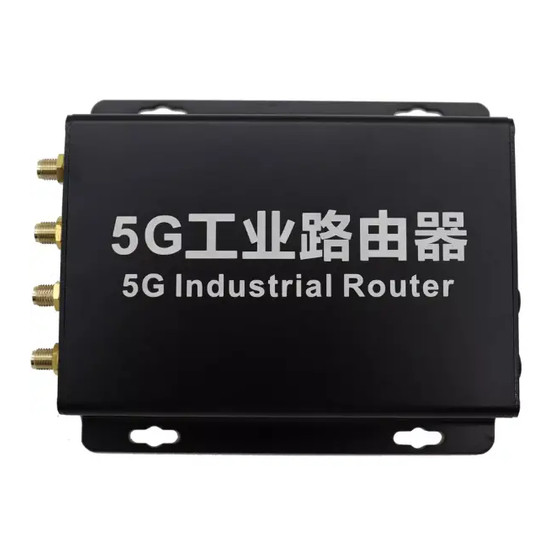
Summary of Contents for EXVIST V519
- Page 1 Data Transfer Unit Model: V519 4G/3G Industrial Router 4G/3G Serial Server User Manual Model:V519 - 1 -...
- Page 2 Data Transfer Unit Model: V519 1.Interface Front 1) RJ45 Jack: LAN0 2) RJ45 Jack: LAN1 3) DC Jack: DC7V~35V wide voltage, DC12V is better and recommended. Description: LAN0 can be used as WAN under regular router mode; DC: 2.1mm Standard Round Interface, 7V~35V, Internal:+, Outside: - Back 1) 3G/4G/WIFI Antenna: SMA external rotation internal hole interface.
- Page 3 LAN0 of router (the default IP address for LAN0: 192.168.8.1, subnet mask: 255.255.255.0). 2.3 Connected to WiFi Check whether there’s WiFi hotspot started with V519-XXXXXX(SSID), then click “connect” and enter password (87654321 by default) to establish wireless connection.
- Page 4 Data Transfer Unit Model: V519 2.5 Access router from browser Start a browser like Chrome, Firefox, Edge etc. Enter http://192.168.8.1 in the address column Enter username and password (admin by default) and it’s shown as below: After login, you will be able to configure and manage this router.
- Page 5 5.1 LTE In this page, it allows users to configure LTE. By default, it’s LTE Gateway mode for V519, just inserting 4G/3G SIM card, later router will auto recognize and register to corresponding network of 4G/3G. You can also configure and...
-
Page 6: Vpn Client
Data Transfer Unit Model: V519 select ISP. 5.2 Custom APN Please enter the APN information provided by ISP. The APN information of the domestic three ISPs for your reference as below: 3G/4G Dial Number User Password TD-SCDMA China Mobile cmnet... - Page 7 Data Transfer Unit Model: V519 6.2 LTE GPS LTE GPS is one of optional features because it uses the GPS built-in the 4G modules. If it’s required to enable GPS, please go to Network-->LTE-->GPS and enable GPS. If it positions successfully, you will see the map below.
-
Page 8: Serial Port
Data Transfer Unit Model: V519 corresponding port to get the GPS information. 6.3 Serial Port Only 1ch RS232 can be supported. RS485 can be customized if required. The serial port can also be worked as GPS positioning, terminal command line, ModBus, data transparent transmission. -
Page 9: 1Operation Mode
Data Transfer Unit Model: V519 7.1.1Operation Mode 5x operation modes can be selected: LTE Gateway (By Default), Gateway, 2.4G WISP, AP, Mix. Please see below photo: 1. LTE Gateway By default, it’s LTE Gateway mode, all you have to do is to insert 3G/4G SIM card, then the router will auto recognize and register to the corresponding network of 3G/4G. - Page 10 4. AP (Access Point) Please go to System->Device->Operation Mode->Select “AP”->Confirm. Try to connect the WAN port of V519 to the LAN port of the primary router via ethernet cable, then it can turn your wired network into wireless network. 5. Mix In the Mix mode, it supports 4G, wired, wireless backup.
- Page 11 Data Transfer Unit Model: V519 wireless connection enter related parameters: Click “Interface” and you’ll see it’s all connected to 4G and WiFi: - 11 -...
- Page 12 Data Transfer Unit Model: V519 7.6 Manage Server In this page, it allows users to configure parameters of remote management server. After configuration, the router can be connected to the remote server, through remote server, it’s okay to configure the router. But for remote management server, the customized integration protocol will be required.
-
Page 13: Fcc Caution
FCC Caution. § 15.19 Labelling requirements. This device complies with part 15 of the FCC Rules. Operation is subject to the following two conditions: (1) This device may not cause harmful interference, and (2) this device must accept any interference received, including interference that may cause undesired operation. §...

Need help?
Do you have a question about the V519 and is the answer not in the manual?
Questions and answers